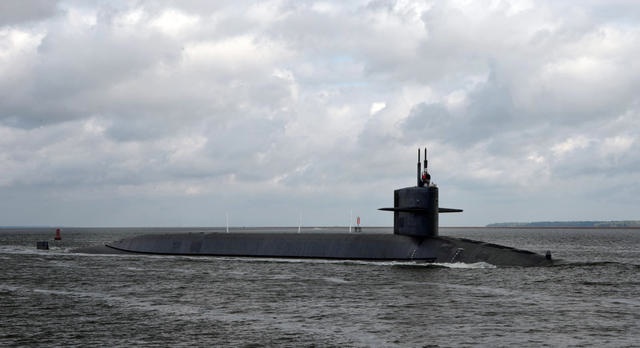
Women will soon serve aboard the USS Wyoming, pictured here, and three others like it / Navy photo by James Kimber
I finally had the opportunity to tour a Trident-class submarine; you know, the large ballistic missile boats, four of which are soon to be home to several women officers. I was surprised at how big it was inside…yet not. Being a surface sailor, I was trying to visualize how this ship could be configured to accommodate enlisted women (one thing is for sure: a separate head will have to be installed somewhere).
I say this because the current configuration includes two head facilities for the enlisted folk. Each of these two facilities includes four toilets and sinks, and two showers. And that is for approximately 125 sailors. If enlisted women are integrated at the current policy percentage, approximately 15 to 20% of the crew, that would mean that only 18 to 24 enlisted females would be assigned. It would be a very bad idea to give one whole head facility to the women and expect the remaining 100 men to use the other.
Very bad for morale; but especially bad for the women who would have to take the brunt of the complaining. Better to give them their own small head, which would require some modification to the sub; it could perhaps be carved out of one of the small six-bunk berthing areas.
The berthing situation seemed a bit more tenable. We saw enlisted berthing areas of six bunks each in spaces between the missile tubes. In other areas of the boat, we saw individual racks that would be laid for more junior personnel between storage lockers. In all cases, the nod to privacy was only a curtain that covered the opening to the space. As with all berthing areas, it would be incumbent upon the crew to maintain a semblance of privacy for each area.
I was not able to find out what training arrangements are being conducted for the officers and crew of the ships that are being integrated. When surface ships were integrated, both in the late 1970s when women were assigned to non-combat ships, and in the mid-1990s, when they were first assigned to combat ships, there was a training program that helped facilitate the integration. Both the officers and crew were given information on helping the women become part of the team, rather than isolating them and treating them differently. I hope the submarine community is doing the same thing.
In doing a bit of on-line research into the subject, I also found the normal adverse and “sky is falling” reaction to the whole scenario. There were accusations of the Navy conducting a “social experiment”, warning that rapes and sexual harassment will be ubiquitous, indicating that the boats will be unable to complete their missions because of all the pregnant women , or that the submarines would become the undersea equivalent to Sodom and Gomorrah.
Really. Well, I would like to think that because submariners are double volunteers (volunteering not only for the Navy, but for submarine duty), and that they need a high Armed Services Vocational Aptitude Battery test score to qualify for the duty, that they would be smarter and more mature than the average sailor. Because they also have a very long training pipeline, 11 to 18 months, they would also be higher in rank when they get to their first boat. Higher rank, intelligence, and maturity are all indicators of people who would be less likely to harass others.
For women, it also corresponds to being less likely to succumb to unwanted pregnancy. It is also my experience that command climate makes a difference in the susceptibility of the crew towards harassment and illicit fraternization. Leadership that sets high standards and offers positive role models are key in how the crew acts towards others, whether it be officers towards enlisted personnel, straights towards gays, or men towards women, and vice versa.
It is important that in an all-volunteer force that everyone’s rights, and right to privacy, such that it may be on a submarine, be respected. No one should ask for anything less. Navy leadership has indicated that enlisted women will be integrated in submarines at some point in the future. Now is the time to start thinking about acting like the professional sailors they are and embracing the possibilities.
As one former submariner has said, “The right females could actually enhance our warfighting capability. Let’s not forget that at a molecular level, women are fundamentally different than men in every aspect, and it is this difference that could be vitally valuable in battle. By leaving women on the pier, we leave behind all their different thought patterns, intuition and talent, all of which could mean winning a battle that would otherwise be lost.” Right on, brother!


